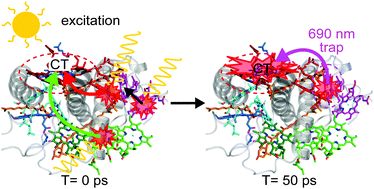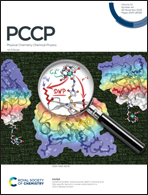Complete mapping of energy transfer pathways in the plant light-harvesting complex Lhca4†
Abstract
The Lhca4 antenna complex of plant Photosystem I (PSI) is characterized by extremely red-shifted and broadened absorption and emission bands from its low-energy chlorophylls (Chls). The mixing of a charge-transfer (CT) state with the excited state manifold causing these so-called red forms results in highly complicated multi-component excited energy transfer (EET) kinetics within the complex. The two-dimensional electronic spectroscopy experiments presented here reveal that EET towards the CT state occurs on three timescales: fast from the red Chls (within 1 ps), slower (5–7 ps) from the stromal side Chls, and very slow (100–200 ps) from a newly discovered 690 nm luminal trap. The excellent agreement between the experimental data with the previously presented Redfield–Förster exciton model of Lhca4 strongly supports the equilibration scheme of the bulk excitations with the dynamically localized CT on the stromal side. Thus, a complete picture of the energy transfer pathways leading to the population of the CT final trap within the whole Lhca4 complex is presented. In view of the environmental sensitivity of the CT contribution to the Lhca4 energy landscape, we speculate that one role of the CT states is to regulate the EET from the peripheral antenna to the PSI core.



 Please wait while we load your content...
Please wait while we load your content...